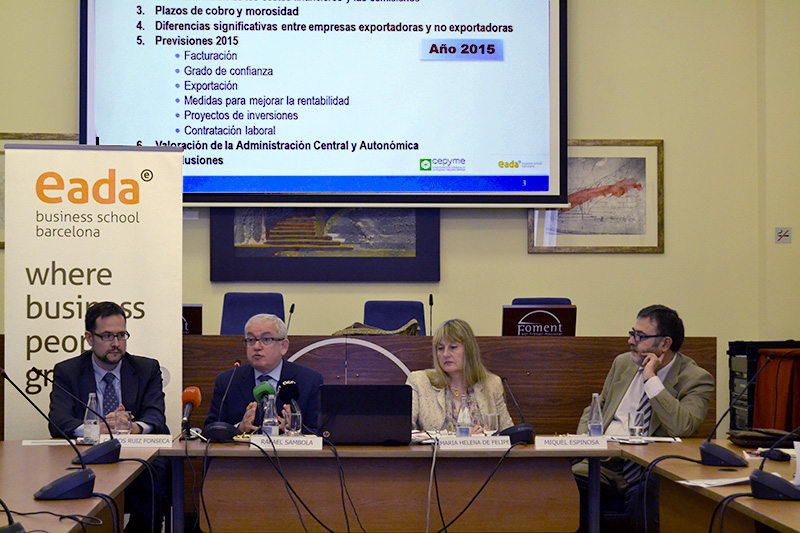VI Financial Diagnosis of Spanish Companies by EADA and CEPYME
Spanish companies are coming out of the economic crisis
EADA and the CEPYME have issued a moderately optimistic message during the presentation of the VI Diagnóstico Financiero de la Empresa Española for the 2014 financial year. This survey, based on a sample of over 700 companies, was answered by financial managers in different sectors, and points to a change in trend with regard to 2013 and a gradual recovery from the recession of the past years.
Main signs of recovery

If we compare with the data from the 2013 report, one of the conclusions is that Spanish companies have scored better, to a greater or lesser extent, in all the financial indicators that were studied. According to Rafael Sambola, professor of Finance in EADA and one of the authors of the study, the most significant piece of data is the recovery in sales, whereby average turnover dropped by 0.4% in 2013 and rose by 0.3% in 2014. “Although this rise is very small it marks a turning point after four years of negative growth”, he pointed out.
Another indicator that Sambola referred to is the improved profitability of companies –measured as the profitability of investments in productive assets-. In this case, it has risen from 5.6% to 6.1% taking into account only companies with operating profits when calculating the average. In his opinion “this is a significant piece of data and it points to the effectiveness of the measures adopted by companies over the last years”.
The author of the report also mentioned other indicators which point to an economic recovery. One of them is the lower bad debt rate for sales which has dropped from 4.8% in 2013 to 4.3% in 2014, in other words for every 100 euros invoiced by a company 4.3 € are not collected or are collected with difficulty. “This is a significant improvement if we take into account that the rate in 2011 was almost 9%” he added. Another relevant indicator which points to a slow recovery is the average collection period, which has dropped from 80 days to 71 days.
On this point however, Mª Helena de Felipe, vice president of CEPYME and president of FEPIME, is less optimistic and considers that “bad debt continues to be a significant obstacle for companies, a third of which state that they still have difficulties when it comes to accessing credit”. On the other hand, she points out, “companies with operations abroad are those that have reduced their bad debts to a greater extent and have also shown more profits and increases in sales in comparison with those that do not export”.
Rosy prospects for 2015
Rafael Sambola bases his theory of an economic recovery on the good prospects for 2015 which are also featured in the EADA and CEPYME report. In this respect, the estimates are based on three significant aspects which show that Spain is emerging from the crisis. The first is that the main corporate management measure for 2015 will not focus on cutting personnel costs but on promoting the commercialisation of their products and in giving priority to launching new lines of business.
The second aspect is better prospects in the area of sales. “the most likely hypothesis is that 58% of companies will improve their turnover compared to 2014”, Mr Sambola added.
And finally, it is worth mentioning that the percentage of companies that plan to invest in non operating assets during 2015 has increased moderately, reversing the downward trend of recent years.
Although the prospects in the job market are still weak, the EADA professor considers that there has been a slight increase in the number of companies that intend to hire new personnel in 2015, more specifically 32%.
